On July 3, the latest research findings from the environmental archaeology team at Lanzhou University regarding the Baishiya Karst Cave site were published online in the prestigious journal Nature. The paper, titled "Middle and Late Pleistocene Denisovan subsistence at Baishiya Karst Cave," was co-led by Professor Zhang Dongju from the School of Earth and Environmental Sciences at Lanzhou University and Academician Chen Fahu from the Institute of Tibetan Plateau Research, Chinese Academy of Sciences. The research team included members from Lanzhou University’s Palaeolithic Environmental Archaeology Team, in collaboration with several international research institutions, including the University of Copenhagen in Denmark, the Max Planck Institute for Evolutionary Anthropology in Germany, the University of Kent in the UK, and the Collège de France. The first author is Xia Huan, a postdoctoral researcher at Lanzhou University, with co-first authors Wang Jian from Lanzhou University and Zandra Fagernäs from the University of Copenhagen. The corresponding authors are Professor Zhang Dongju, Professor Chen Fahu, and Associate Professor Frido Welker from the University of Copenhagen. Several master's and doctoral students from the School of Earth and Environmental Sciences at Lanzhou University also contributed significantly to this research. The project was supported by various governmental bodies, including the State Administration of Cultural Heritage, Gansu Provincial Bureau of Cultural Heritage, Gansu Provincial Institute of Cultural Relics and Archaeology, Gannan Prefecture Bureau of Culture, Broadcasting, and Tourism, and local governments such as the CPC Xiahe County Committee and the Xiahe County Government, as well as several funding bodies, including the National Natural Science Foundation of China and the China Postdoctoral Science Foundation.

Research Article on Baishiya Karst Cave in Nature
This research employed a combination of traditional zooarchaeology and ancient protein analysis methods (ZooMS and shotgun proteomics) to systematically identify and analyze over 2,500 animal fossil remains unearthed from the Baishiya Karst Cave site in Xiahe County, Gansu Province. These fossils were excavated under the leadership of Professor Zhang Dongju. The study conducted species identification, anatomical analysis, and bone surface mark examinations, combined with previous research findings at the site, to deeply explore the ancient human activity history and survival strategies at this site.
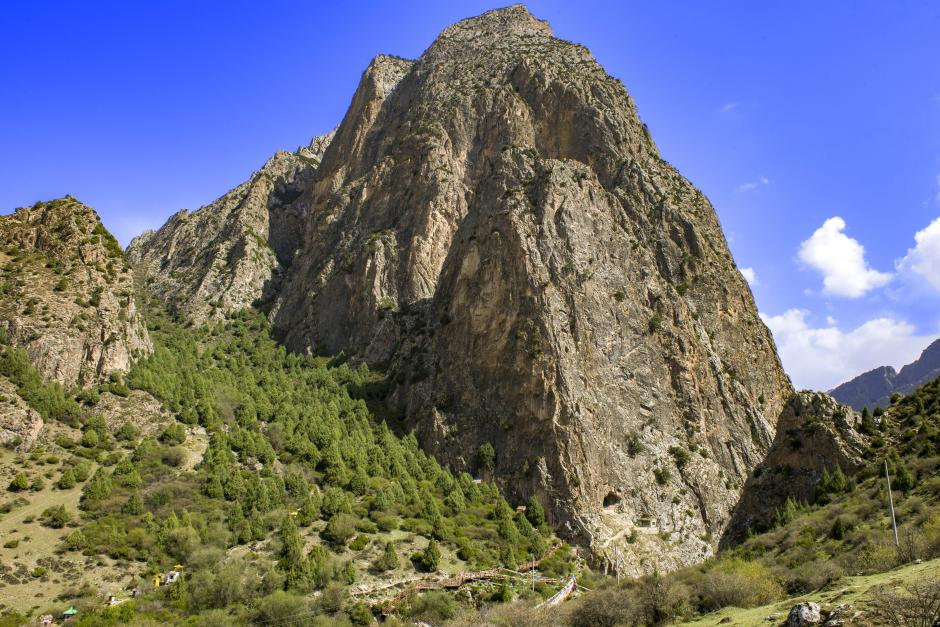
Exterior View of Baishiya Karst Cave
Through rapid screening of over 2,000 fragmented bones lacking morphological identification features using ZooMS, a rib bone specimen from Layer 3 (dated to approximately 48,000 to 32,000 years ago) was identified as a human fossil. Further analysis using proteomics confirmed that this fossil belonged to a Denisovan, providing conclusive human fossil evidence for Denisovan activity at Baishiya Karst Cave during the Late Pleistocene. In 2020, the team published findings on the sediment DNA of the Baishiya Karst Cave site in Science (Zhang et al., Science, 2020), reporting Denisovan mitochondrial DNA extracted from sediments dating to 100,000, 60,000, and possibly as recent as 45,000 years ago. This, combined with the team's 2019 publication in Nature on a Denisovan mandible dated to at least 160,000 years ago (Chen et al., Nature, 2019), confirmed that Denisovans lived on the Tibetan Plateau from the late Middle Pleistocene to the Late Pleistocene. The new discovery extends the latest survival time of Denisovans to approximately 40,000 years ago, providing valuable new material for studying Denisovan physical and genetic characteristics, activity history, and high-altitude environmental adaptation. It also offers crucial new clues for research on the coexistence and gene and cultural exchanges between Denisovans and early modern humans in East Asia.
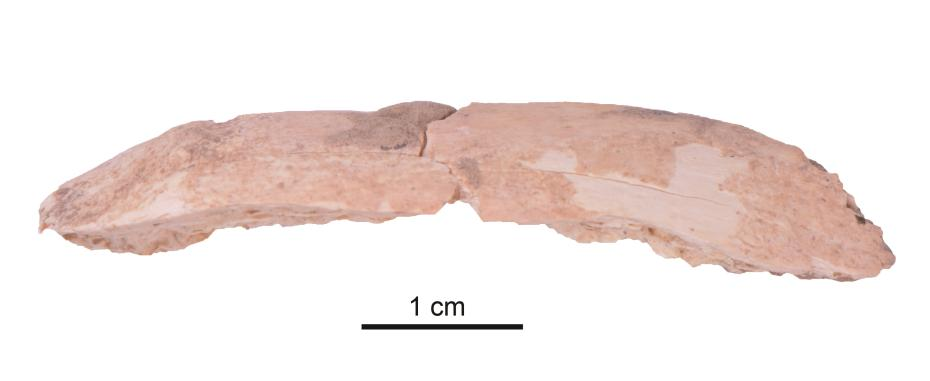
Newly Discovered Denisovan Rib Fossil
Furthermore, this study systematically explained the animal resource utilization strategies of the Denisovans at Baishiya Karst Cave. The research identified more than 20 vertebrate categories, including extinct species, species unique to the Tibetan Plateau, and species widely present in the Palearctic realm today. These included large and medium-sized herbivores such as blue sheep, argali, wild yaks, red deer, Tibetan gazelles, musk deer, wild horses, and woolly rhinoceroses, as well as carnivores like spotted hyenas, leopards, martens, stone martens, wolves, and Tibetan foxes, and birds like pheasants, golden eagles, and quails, along with small mammals such as plateau pikas, pika, voles, porcupines, and Gansu zokor. This first revealed the vertebrate fauna situation on the Tibetan Plateau from the late Middle Pleistocene to the late Late Pleistocene.
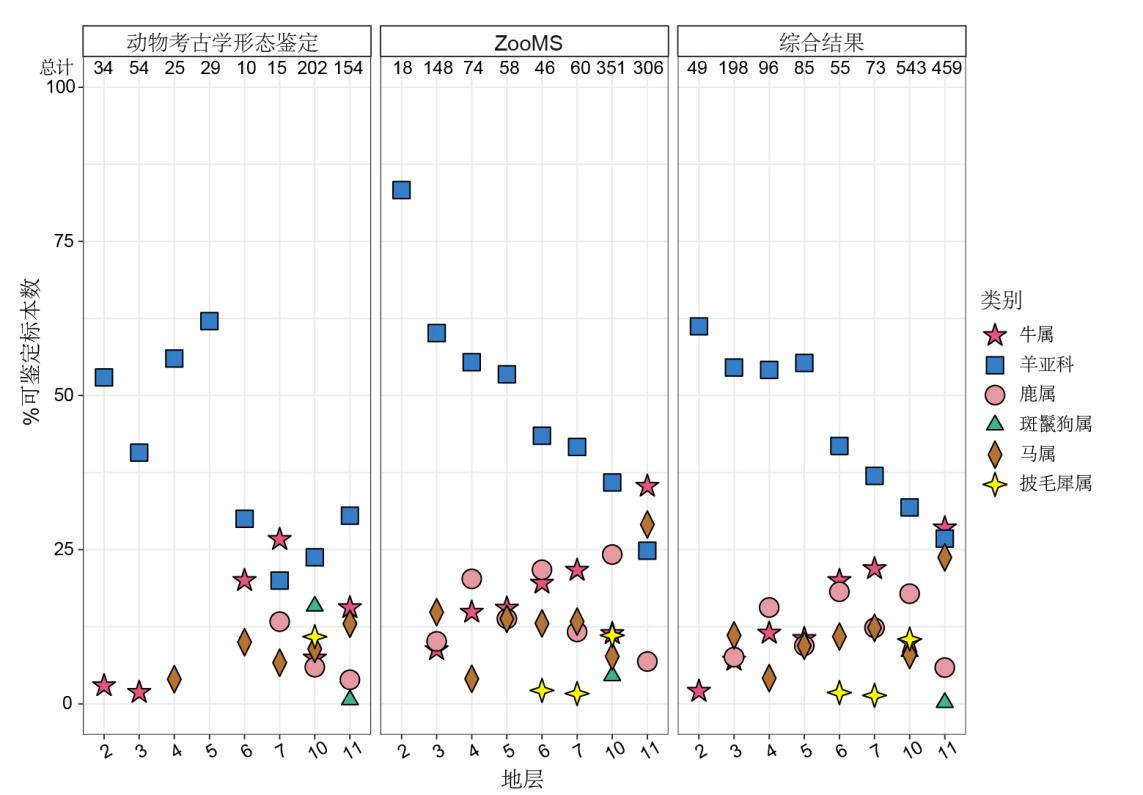
Changes in Major Animal Categories in Different Layers of Baishiya Karst Cave
Comprehensive analysis showed that Denisovans at Baishiya Karst Cave lived in a natural environment dominated by grassland landscapes, with scattered forest resource patches around. They utilized diverse animal resources with a broad diet, engaging in activities such as skinning, dismembering, defleshing, and bone marrow extraction within the cave, and also attempted to make simple tools from bones.
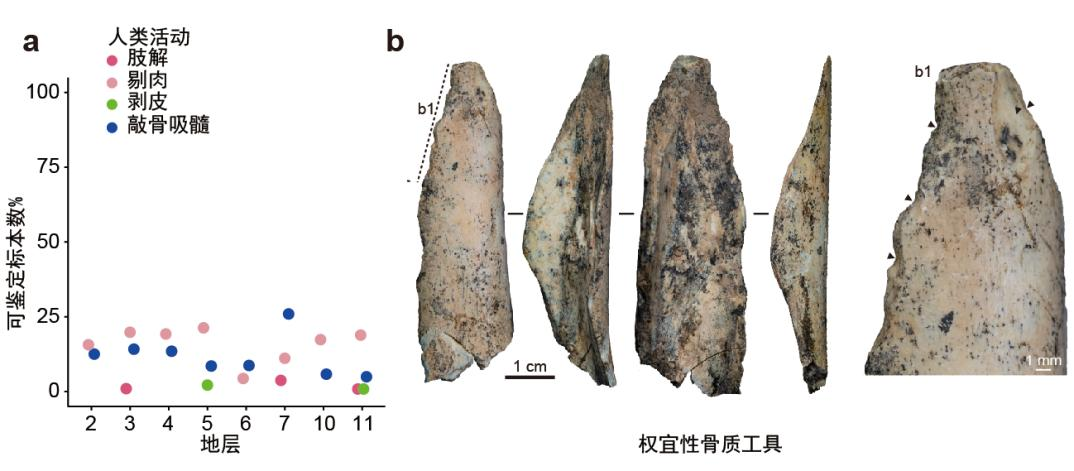
Denisovan Processing and Consumption Activities (a) and Makeshift Bone Tools (b) at Baishiya Karst Cave
This research, through the comprehensive analysis of ancient proteomics and zooarchaeology, for the first time revealed the animal resource utilization strategies of the extinct Denisovans during their long-term occupation of the Tibetan Plateau (from approximately 224,000 to 32,000 years ago, from the penultimate glacial period to the last glacial period). It provides reliable evidence for understanding early human activity history on the Tibetan Plateau. This study is also the first in China to use a combination of ancient proteomics and zooarchaeology methods in a Palaeolithic archaeological site, marking the third international top journal article based on Baishiya Karst Cave research by Lanzhou University’s environmental archaeology team.
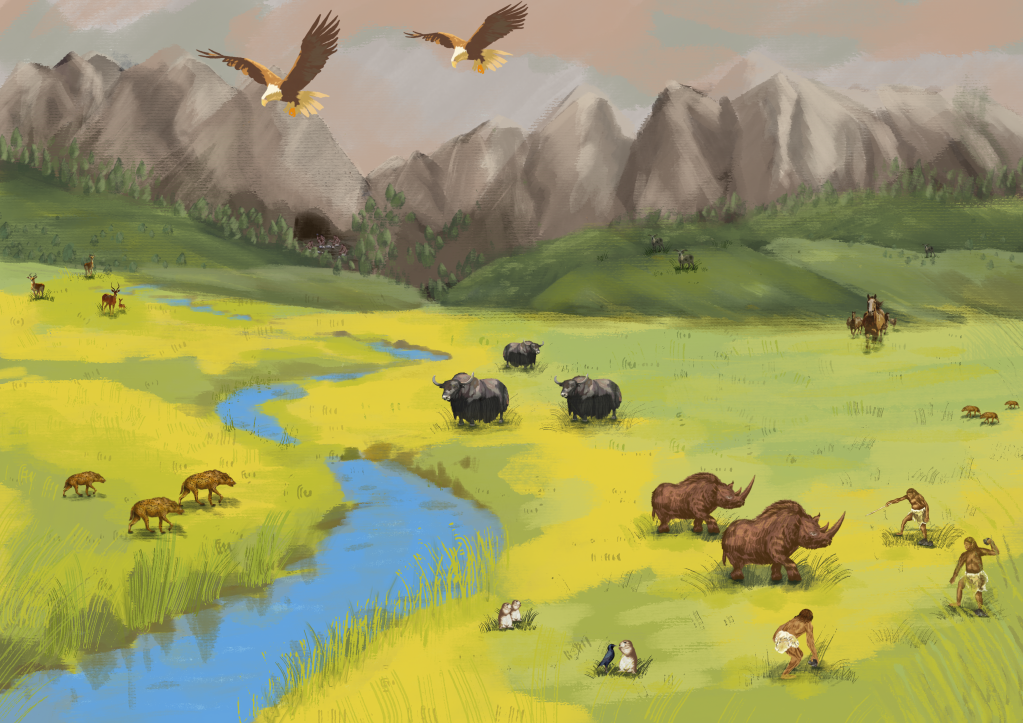
Reconstruction of Ancient Human Living Scene in Gansu Basin (Illustrated by Li Xia)
The continuous publication of Baishiya Karst Cave research findings in top international journals not only significantly expands our understanding of Denisovan and early human activities on the Tibetan Plateau but also highlights the research strength and international influence of Lanzhou University’s environmental archaeology team in the field of ancient human activity history on the Tibetan Plateau. The environmental archaeology team, founded by Academician Chen Fahu in the mid-1990s, has developed into a comprehensive research team covering multiple research directions, including the Palaeolithic era, Neolithic era, and historical period environmental archaeology. The Palaeolithic Environmental Archaeology Team, led by Professor Zhang Dongju, has conducted extensive archaeological surveys, excavations, and research in the northeastern Tibetan Plateau for many years. The team aims to answer important scientific questions about the spread of Palaeolithic populations to the Tibetan Plateau, their activity history, population characteristics, cultural aspects, subsistence modes, and environmental adaptation. Supported by policies and funding from various national departments and with the strong cooperation of local governments, and leveraging platforms such as the Key Laboratory of Western China's Environmental Systems, Ministry of Education, and the National Key Research Base of Bioarchaeology in Cold and Arid Regions, the research strength of Lanzhou University’s environmental archaeology team has gradually improved. In addition to the research at the Baishiya Karst Cave site, the team has conducted extensive archaeological surveys in the northeastern Tibetan Plateau, discovering several important Palaeolithic archaeological sites, and completed or are conducting multidisciplinary comprehensive research on several sites, covering almost all known periods of Palaeolithic activity on the plateau. This latest research achievement is the fourth academic paper led by the Palaeolithic Environmental Archaeology Team published in Nature/Science since 2017 (Zhang et al., Science, 2017; Chen et al., Nature, 2019; Zhang et al., Science, 2020; Xia et al., Nature, 2024), highlighting the team's leading international position in the study of prehistoric human activities on the Tibetan Plateau. The new team member, Dr. Xia Huan, has promoted the application of ancient protein analysis technology in the identification of ancient human fossils and the study of ancient human subsistence strategies in China, advancing the development of the emerging field of ancient proteomics in China. In the future, Lanzhou University’s Palaeolithic Environmental Archaeology Team will continue to strive, aiming to contribute more of Lanzhou University's strength to the research on the evolution and environmental adaptation of ancient humans in East Asia and to the development of this field.
Article Link:https://www.nature.com/articles/s41586-024-07612-9
Paper Link:
Xia, H., Zhang, D. J. et al., 2024. Middle and Late Pleistocene Denisovan subsistence at Baishiya Karst Cave. Nature,https://doi.org/10.1038/s41586-024-07612-9.
Further Reading:
Zhang, D. J. et al., 2020. Denisovan DNA in Late Pleistocene sediments from Baishiya Karst Cave on the Tibetan Plateau. Science, 370, 584-587.
Chen, F. H. et al., 2019. A late Middle Pleistocene Denisovan mandible from the Tibetan Plateau. Nature, 569, 409-412.
Zhang, D. J. et al., 2017. Comment on “Permanent human occupation of the central Tibetan Plateau in the early Holocene”. Science 352, eaam8273 (2017).